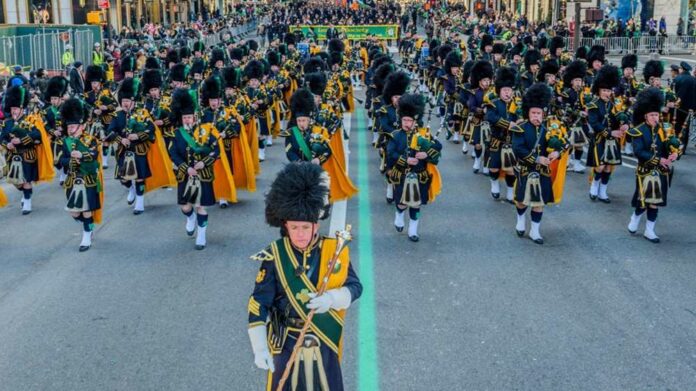March the 17th is the anniversary of the death of St Patrick the patron saint of Ireland in the fifth century. In Ireland this day has been observed as a religious holiday and a day of celebration for more than 1,000 years. When you look at its history you will realize that it is more deeply ingrained in the Irish spirit and psyche and more special to them than even its most fervent adherents fully realize.
St. Patrick’s Day falls during the Christian penitential season of Lent which in the past included the strict observance of fasting and abstinence. There was a relaxation of this allowed for St. Patrick’s Day. Lenten prohibitions against meat eating were relaxed for the day so people would eat, drink, sing dance and feast. The traditional midday meal of Irish bacon and cabbage started the celebrations. Irish families traditionally attended Mass in the morning and then after their special midday meal they would celebrate into the afternoon and evening or gather for a party.

Penal Times
In the darkest days of penal times when there was a price on a priests head and the celebration of Mass was forbidden, the people filed in silence to a ‘Mass Rock’ which was their hidden alter in some remote place. A priest ventured forth at the risk of his life and celebrated Mass on St Patrick’s Day with the sky as his cathedral roof. The risk filled silent filing to and from Mass was the St. Patrick’s Day parade of those darkest of days in Ireland when people kept the faith despite the dispossession and confiscation of their land and relentless persecution and abuses. Those Mass Rocks can still be found throughout Ireland and seen as monuments to a people persecuted but never bowed and who kept the spirit of Ireland alive.
New World St Patricks Day
The first ever record of a St. Patricks Day parade in the New World honouring the Catholic Feast Day of St. Patrick, Ireland’s patron saint was held in what is now St. Augustine, Florida on March 17th, 1601. While this was the first recorded St Patricks day parade early Irish settlers to the American colonies may have already been celebrating the feast of St Patrick in many ways including parades. Apart from St Brendan some of the earliest Irish people to arrive in the New World travelled as members of the Spanish garrison in Florida during the 1560’s.
This first recorded St. Patrick’s Day parade was held in a New World Spanish colony on March 17, 1601 under the direction of Ricardo Artur the colony’s Irish vicar.
St Patrick Moves North
Many of the early Irish to arrive in the English speaking colonies of America were indentured servants who brought their Irish tradition of celebrating St. Patricks Day to America with them. Many of them had memories of first filing silently to and from a hidden Mass Rock in Ireland and risking their lives to celebrate St, Patrick’s Day in penal times before arriving in America to celebrate their faith and St. Patricks Day Openly. That was surely a cause for celebration but those earliest celebrations of St Patricks Day were an emigrant communities coming together event, and a celebration of their deliverance from persecution as well as the joy of being able to celebrate their faith and St. Patrick’s Day openly. Can we ever truly appreciate what a special occasion celebrating St Patrick’s Day was and what it meant to those early emigrants?
St Patrick Moves to the City
More than a century later in 1737 Irish soldiers serving in the English military paraded in honour of St Patrick on March 17th in Boston. New York City finally had its first St Patrick’s day parade in March 1762. After 1765, to escape the misery of English oppression emigration from occupied Ireland became a relentless national enterprise. By 1890, 40% of Irish-born people were living outside of Ireland. An estimated 100 million people worldwide now claim some Irish descent including up to 40 million Americans claim who Irish as their primary ethnicity. The result of this is that St Patricks Day parades are now a worldwide phenomenon.

St. Patrick the Man
Saint Patrick was born into a Christian family in Roman Britain in the late 4th century. He is considered to be one of the most successful Christian missionaries in history. He was taken prisoner by Irish raiders at the age of 16 when they attacked his family’s estate. They brought him to Ireland where he spent six years enslaved as a shepherd before escaping home to Britain. Believing he had a calling from God to Christianize Ireland, he joined the Christian Priesthood AD, and by his death in 461AD, Ireland was almost entirely converted to Christianity.

